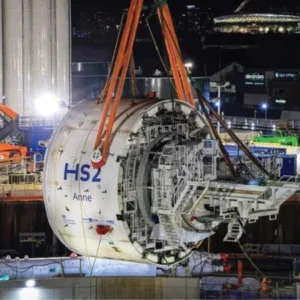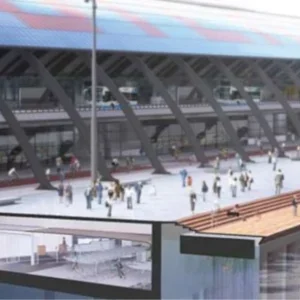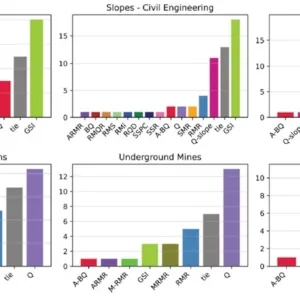A 16km metro line aims to remove 2,000 cars per hour during peak traffic and carry some 300,000 passengers a day, easing the strains of growth in the north and west districts of Rio de Janeiro. A complex array of construction methods and technologies are advancing he construction of the line beneath the densely population favelas. While above ground a mix of retaining walls, bridges and at grade construction methods are driving the line through the varied topography.
Lúcio Silvestre, contract director of the building consortium Consórcio Construtor Rio Barra, responsible for the construction of Line 4 connecting Barra da Tijuca and Gávea says: "This is a highly complex construction project with cutting edge engineering solutions.
"The main challenge is to develop geotechnical models for underground works, while combining logistics and community relations, so as to avoid inconvenience in the daily life and routine of the surrounding population."
Managing Inconvenience
Projects in densely populated areas often face two major challenges. First, how to undertake a major construction project without bringing the city to a standstill by flooding the streets with site equipment and materials movements. Second, and a challenge particularly difficult for Line 4, how to minimise the impact on surrounding buildings.
The Rocinha favela, a 1940s and 50s slum now home to some 70,000 inhabitants in an area of just 1.43km2, occupies an area of hills and valleys directly above center of the tunnel route.
The houses are poorly constructed and as high as eight stories in some parts. A landslide in 2010 warned engineers of the weakness of the geology to be cut through. The lack of sewerage systems has further weakened the 8m of fractured rock and up to 15m of soil cover.
Through this section the tunnels will be mined by drill and blast. A wide range of monitoring solutions have been employed to give early warning of blast vibrations breaching the 6mm/s limits or ground movement putting the buildings at risk of damage.
Repression pins, piezometers, seismometers and tassometers are used to monitor at the moment of detonation and some 50 homes are monitored daily with repression pins. Seismographs and geophones are used to monitor vibration from the blasting.
Along the drill and blast route the tunnels cuts through very old rock.
"In São Conrado and Barra da Tijuca, Biotite Gneiss and Augen Gneiss rocks were excavated. As Gneiss is a rock of metamorphic origin resulting from the deformation of sediments and/ or granite, it can be seen right at the entrance of the Barra tunnel under the Focinho do Cavalo Hill. That is the longest rock-excavated two-way tunnel connecting subway stations in the world, with 5km of length. Biotite Gneiss and Augen Gneiss are the main types of rock that also make up the Sugar Loaf, for example. These rocks are from the Neoproterozoic era, aged 541 million to one billion years. It is so old, that the continents had not even been formed yet. The same type of rock can be found on the land where the Gávea Subway Station is being excavated."
The drill and blast sections have made steady progress, advancing and average of 4m per day, which now have more than 8,000m of twin bore tunnel with an area of 35m².
"Excavation works progress according to the Bieniawski Rock Mass Rating, adopted in the design of rock excavation works to assess rock characteristics and determine how much it can be gone forward at each blasting," says Silvestre.
There are typically two detonations per day. Seven jumbos spend an average of two and a half hours to drill 71 holes, 13 of them pilots and the rest set over the usual 35m² cross section. Each blast will advance some 3.5m. Some 100m of muck is removed by nine excavators. Three eight hour shifts work the excavation 24 hours a day.
The tunnel is supported by arches with rock bolts, wire mesh and shotcrete.
Silvestre says, "The biggest challenge we have been facing are the logistics conditions, as we need to work in urban areas with large pieces of equipment, and carrying out controlled blasting in order to minimise any impacts to the buildings and traffic, and very few open areas next to our work sites.
"Supporting work sites were set up at strategic spots for the smooth progress of the work and less impact on the surrounding areas. Traffic studies and special traffic operations supported by Rio’s city government minimised the effects of temporary road changes. At the squares of Ipanema and Leblon, in the south, where two subway stations are excavated, recreational areas and senior workout facilities were maintained throughout the construction period."
TBM drive
On the Barra da Tijuca to Ipanema stretch of the drive, the ground is made up of rock and saturated sand with a high water table. "Probing studies, geological surveys and the subsoil tests conducted before constructions commenced showed that the TBM is the most suitable and safe set of equipment to perform this type of engineering work in the south of Rio de Janeiro, a densely populated area," says Marcos Vidigal, contract director of building consortium Line 4 Sul, responsible for the construction of Line 4 connecting Ipanema and Gávea.
The Herrenknecht TBM cutting Rio de Janeiro’s underground is an EBPM. Weighing 2,700t, 120m in length by 11.5m in diameter (as tall as a four-story building), this is the largest piece of construction equipment ever used in Latin America, according to the operators, and the biggest one ever used in subway constructions in Brazil.
While excavating, the TBM deploys the concrete rings that line the tunnel. The ring moulds were also manufactured in Germany by Herrenknecht. Made of steel, each mould section makes one ring section and each ring is made up of eight parts. The plant has five sets of moulds, each with eight sections, and the concrete rings are produced in a carousel system, which is similar to an auto assembly line: each mould has a dedicated worker monitoring it.
Once they leave the mould sections, the ring sections are lifted by vacuum hoists up to a curing tunnel heated at a temperature ranging from 40 to 50 degrees. They are left there for five to six hours to speed up curing. Once the ring sections leave the curing tunnel, they are taken to a storage facility. They remain there for about 28 days to complete the curing cycle.
Vidigal says "The machine began operations in December 2013 and tunneled about 400 meters. In this construction project, the plans are to excavate 15 to 18m on average per day once the equipment is operating full steam ahead at a speed four times faster than the method previously used in Rio.
Sinkhole
In the early hours of 11 May 2014, two sinkholes appeared on Rua Barão da Torre in Ipanema, where the TBM was excavating. Vidigal explains, "The outcome of the analyses of soil settlement that occurred in the morning of May 11 at Rua Barão da Torre in Ipanema shows that the incident was caused by an abnormal and specific behavior in the fractured rock face during the excavation of the subway tunnel in that street. The rock was dismantled and affected small neighbouring blocks, thus causing decompression of the soil. The process then evolved up to an area of sandy soil, and on to the surface."
The study also shows that four factors were at play in limiting the impact of incident: the excavation method, pretreatment of soil, monitoring of the ground and surrounding buildings’ stability, and the prompt and efficient deployment of the Contingency and Emergency Plan.
"As soon as the first gap on the surface was found, the area was blocked off, excavations were suspended and it was found that there was no risk to the foundations of the surrounding buildings, as it was a localised incident. Once the area was blocked off, water and gas services were stopped and the holes were filled with concrete.
In a construction project of this size, the buildings surrounding the excavation of tunnels and stations are permanently monitored. The buildings receive instruments (settling pins and inclinometers) to monitor how buildings behave before and during construction works. The results from these instruments are within the expected limits and the buildings are not at risk."
The project maintains that the use of TBM is the "most suitable and safe piece of equipment for tunnelling the subway that will connect Ipanema and Gávea."
Metro Line 4 is expected to go into operation in the first half of 2016
The project
Tunnels of Rio de Janeiro Subway Line 4 are built using two different construction methods: NATM and TBM. The subway will cover 16km from Barra da Tijuca in the west portion of the city, to Ipanema in the south
Started in June 2010 in the western neighborhood Barra da Tijuca, the tunnel boring operations by June this year had covered more than 8,000m between Barra and Gávea. Over this stretch, the boring operations are carried out using NATM — drill and blast, with controlled blasting. This method is suitable for rock boring, and consists of lining walls and arches with rock bolts, wire mesh and shotcrete, advancing while controlling deformation.
On a daily basis, blasting is monitored by seismographs to control vibrations and monitor noises and building settlements, in addition to instrumentation and previous assessments of the surrounding buildings.
This method was employed in the largest rock-excavated twin-tunnel connecting subway stations in the world, covering a stretch longer than 5km, from Barra da Tijuca to São Conrado.
From Gávea to Ipanema, the tunnel is being bored by TBM, with 2,700t, 120m in length and 11.5m in diameter.
The TBM is building subway tunnels between the stations General Osório (Ipanema) and Gávea, causing a smaller impact on the surface areas.
This construction method is best suited to the geology of Rio’s south portion, consisting of sand, rock and water.
Project players
The concessionaire Rio Barra is responsible for Rio de Janeiro subway line 4 project and is made up of two construction consortia: the construction consortium Rio Barra, which is building the Barra da Tijuca — Gávea subway stretch, including the subway station. The consortium is made up by Queiroz galvão, Odebrecht Infraestrutura, Carioca Engenharia, Cowan and Servix; and consortium Linha 4 Sul, which is building the gávea — Ipanema subway stretch. This consortium is composed of Odebrecht Infraestrutura, Queiroz Galvão and Carioca Engenharia.
EPBM operation
The TBM that is operating in Rio de Janeiro’s underground is an EPBM. The reinforced concrete rings are installed within the shield’s protective housing. For tunneling with a shield in unstable soils, the loss of stability on the tunnel surface is offset by the generation of support pressure.
With an EPB, adjusting the speed of soil removal excavated by the cutting wheel is used to support the tunnel surface. to reach a balanced condition, the support pressure is transferred to the soil by hydraulic cylinders resting under the mounted rings, thus avoiding uncontrolled penetration. The amount of soil removed from the excavation chamber is regulated by the rotation speed of a worm screw, which is set to the advancing speed.
In the front section of the backup, the ring segments are raised one at a time by a transfer hoist. The hoist carries them to the segment feeder and transports them to the front of the tunnel. During this process, the excavation team are protected by the shield housing against earth pressure and water that may come from the water table. The ring sections are installed side by side, alternately. The tail-skin is equipped with a circular seal — this seals the shield steel housing and the segmented ring, preventing a loss of pressure in the face. The annular gap between the exterior contour of the lining segments and the soil is continuously filled with grout injected from the tail-skin injection holes or ring segment to seal the tunnel lining and stabilize it.
At each forward move made by the shield, the backup is pulled on wheels mounted on the tunnel rings. The steel frame also houses the hydraulic power units, pumps, electrical switchboards, ventilation systems, laser navigation instruments and soil conditioner storage tanks. It also houses logistics solutions to deploy the segmented rings and remove excavated materials.






